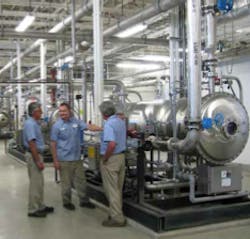Ozone System in Cary, N.C.
Enactment of the Long Term 2 Enhanced Surface Water Treatment Rule and the Stage 2 Disinfectant and Disinfection Byproduct Rule (D/DBPR) will require both large and small drinking water utilities to reduce total organic carbon (TOC), cryptosporidium, and disinfection byproducts (DBPs) in the treated drinking water distributed to the public. Ozonation has helped prepare a North Carolina Water Treatment Plant (WTP) to comply with these federal drinking water regulations and overcome long-standing taste and odor problems of its raw water drawn from the B. Everett Jordan Lake, a nearly 14,000-acre flood control reservoir.
Solution
An ozone system was an important building block in the expansion of the Cary/Apex WTP. The primary purpose of using ozone technology is to oxidize the high levels of iron, manganese, sulfur and organic compounds found in B. Everett Jordan Lake. The city selected the proven, state-of-the-art technology of a two-stage PDO ozone system from WEDECO.
“We took the full leap into ozone as part of our raw water pretreatment after successfully pilot-testing the WEDECO system,” said Kelvin Creech, plant manager. “We had full confidence in the technology before our shovels ever turned the ground.”
The WEDECO ozone system rated from 300 to 3,000 lb per day consists of two 9,000-gal liquid oxygen tanks, three 1,500-lb-per-day ozone generators, two 200,000-gal pre-ozone contactors, four 158,000-gal settled water ozone contactors, a nitrogen boost system, a dissolution system, off-gas treatment, a cooling water system, a calcium thiosulfate system and a gas-leak detection system.
“Our plant has a highly automated system with a lot of instrumentation and control,” said Creech. “We didn’t have any experience with ozone but didn’t require any exotic, fast-track training. Based on our experience here, I would not think ozone treatment presents any negatives.”
Result
One of the most powerful benefits of using ozone as a treatment option is its “green” component. Ozone treats viruses and bacteria without producing the chlorinated DBPs associated with chemical disinfection such as chlorine, making it a popular treatment option for districts that are environmentally aware.
“Ozone has microflocculation benefits that make the pretreatment stage more efficient and makes the plant easier to operate in the sedimentation and filtration stage,” said Creech.
The ozone system allowed the Cary/Apex treatment plant to operate more efficiently in terms of chemical usage.
The plant previously used a substantial amount of powdered activated carbon for odor control, which is no longer required with ozonation. The plant now typically needs 5 mg/L, rather than the 30 to 40 mg/L it used in the years before the addition of ozone. Because of ozone’s disinfection power, the plant has been able to reduce its chlorine use before releasing the finished water into the distribution system.
Another important benefit to using ozone is that the award-winning plant is now in a solid position to be able to successfully meet future regulatory changes.
